Note: this article is adapted from the book: BOOK04 - Build your own development or maintenance bench
On our example bench, click on the link below to access the instruments in the first item in this category, multimeters.
Starting with the Multimeter
There was a time when the presence of a multimeter in a service bag or on a bench characterized only one type of professional: the electronic technician. Times have changed, and today having a multimeter is not the privilege of electronic technicians. More than that, having a multimeter is a necessity that goes beyond the walls of a workshop, reaching ordinary people and professionals from other areas such as electricians, sound installers, computer technicians, antenna and communications system installers and many others.
Electronics evolved, creating new testing instruments and new techniques, but multimeters remained essential elements for working with electricity and electronics. And multimeters have also evolved from expensive instruments, only within the reach of electronics professionals, to reaching a much wider range of users and providing new types of tests.
Today, the multimeter is still the electronic technician's main instrument, with a huge range of types available for this professional with the most diverse characteristics. However, the multimeter is also today the instrument of anyone who likes to work with electricity or electronics and of many professionals in other areas.
The decreasing cost of many multimeters, the ability to provide electrical measurements and simple testing make them ideal for a range of applications that go far beyond the electronics professional.
No one wants to invest more than they need in an instrument they won't use, or invest less in an instrument that doesn't perform exactly the tests they need. More than that, depending on your activity, it may be interesting to have more than one multimeter at your disposal on your workbench.
https://www.incbtech.com/articles/84-instrumentation.html?highlight=WyJpbnN0cnVtZW50YXRpb24iLCJpbnN0cnVtZW50IiwiaW5zdHJ1bWVudHMnIiwiaW5zdHJ1bWVudCdzIl0=
WHAT MULTIMETER TO BUY
When choosing a bench multimeter, there are several factors to consider, as we have seen. The first thing we must analyze is the type or technology.
Analog or digital - which is the best multimeter?
The general belief that electronics practitioners, engineers, students, hobbyists and even long-time professionals have is that, once a digital multimeter can be purchased, the analogue one should immediately be discarded, given to a beginner relative, or even abandoned in a box. of scrap from the workshop. Nothing else wrong!
Analyzing what the digital multimeter can do, we see that, in fact, in a large number of measurements it is much better than the analog one, with greater precision and even greater ease of use and reading, apart from the availability of measurements of other quantities, in addition to of traditional voltage, current and resistance.
However, there are applications in which the old analog multimeter is insurmountable, and for them the digital one, although more sophisticated, is not suitable. If you are thinking about buying a digital multimeter just to "discard" the analogue one, the following explanations will change your mind, and if you are reluctant to buy a digital multimeter as your first multimeter, without even thinking about analogue ones, read what we have to say.
Digital vs analog
In the digital multimeter we have an LCD (liquid crystal) panel that presents in numerical form the quantity being measured value. This value is obtained from a counter that takes samples after an analog-to-digital converter. Rates of one sample per second are common.
This means that, if the value of the quantity being measured varies slowly, the number displayed by the multimeter will keep changing. Typically this happens with the last digit. Thus, if a voltage of 1.235 V is measured on a 3-digit multimeter, the values displayed may fluctuate between 1.23 and 1.24. If the measured quantity itself varies, the same thing will happen. Figure 1 shows this.
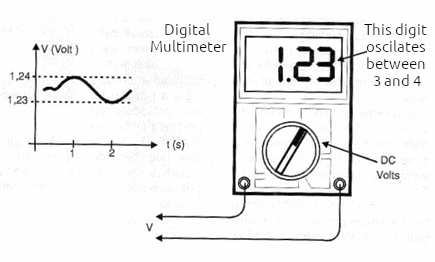
However, if the magnitude variations are too fast, for example, in a circuit that oscillates at low frequencies, there is no time for the sampling circuit to operate correctly, and the display will not be able to show a fixed correct value.
This means that a first limitation for the digital multimeter is precisely when we want to check whether a quantity varies, for example a voltage.
Checking the discharge of a capacitor with a digital multimeter, for example, we will have difficulty taking a reading, since the numbers presented will run quickly and inaccurately, as illustrated in figure 2.
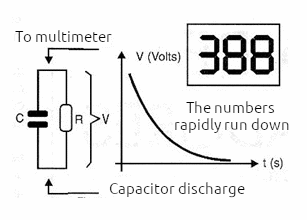
However, using an analog multimeter this problem does not occur we will easily see variations in the measured quantity as the pointer moves, which has a better response to this type of measurement. See figure 3.
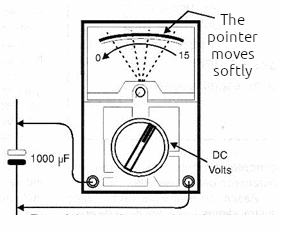
Therefore, when we want to check voltage variations, using an analog multimeter is much more interesting. Another situation can be given as an example. However, using an analog multimeter we can easily see this by the amplitude of the falling movement of the indicator pointer, see figure 4.
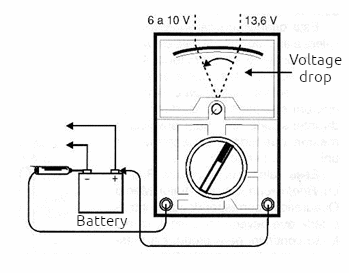
Aware of this problem, many manufacturers of digital multimeters have included an analog scale in their instruments. This scale, shown in figure 5, can be very useful in this type of measurement in which large variations must be observed.
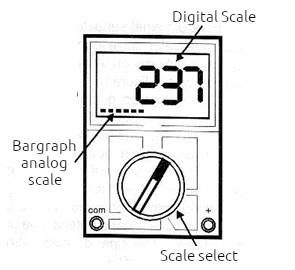
However, even when using this scale, the readiness of the instrument must be checked, that is, the speed with which it can respond to variations in the measurement taken. And, for those who want to know more about this instrument, including how to use it in the most diverse applications, some of which are even uncommon, we suggest the book:
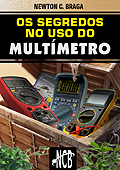
(*) In the instrumentation section of our website you will find many articles on the use of the multimeter.extract from the original book (in English).



